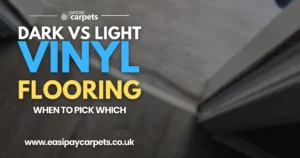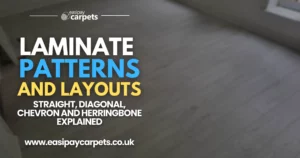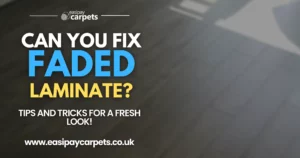

Laminate Flooring Gaps: What Causes Them & How to Fix It
Why Does Laminate Flooring Separate?
Laminate flooring is a popular, durable, and affordable choice for many homes, but one common issue is gaps forming between planks over time. These gaps can be frustrating, affecting both the appearance and stability of your floor.
Understanding why laminate flooring separates can help you fix existing gaps and prevent them in the future.
Common Causes of Laminate Flooring Gaps
1. Temperature & Humidity Changes
Laminate flooring is made from compressed fibreboard, which expands and contracts with temperature and moisture changes.
- Winter (Low Humidity): Dry air causes the planks to shrink, leading to gaps.
- Summer (High Humidity): Increased moisture makes the planks expand, which may push them apart.
✔ Prevention Tip: Use a humidifier in winter and a dehumidifier in summer to keep humidity levels stable.
2. Improper Installation
Laminate flooring must be properly installed to prevent separation.
- Not Enough Expansion Gaps: If the floor is installed too tightly against walls, it has no space to expand, causing it to push apart elsewhere.
- Floating Floor Misalignment: Laminate is a floating floor, meaning it needs to be locked together properly. If gaps form, planks weren’t secured tightly during installation.
- Uneven Subfloor: An uneven base can cause planks to shift, leading to gaps over time.
✔ Prevention Tip: Always leave a 10mm expansion gap around the edges of the room and ensure the subfloor is level before installation.
3. Heavy Furniture Movement
Placing or moving heavy furniture on laminate flooring can cause the planks to separate or shift.
- Pushing furniture without protective pads can dislodge planks.
- Uneven pressure from heavy items (like wardrobes) may force gaps to appear elsewhere.
✔ Prevention Tip: Use felt pads under furniture legs and avoid dragging furniture across the floor.
4. Water Damage
While laminate flooring is water-resistant, excess moisture can cause the core to swell or warp, leading to gaps.
- Spills left too long can seep between planks, causing them to expand and push apart.
- High humidity levels in kitchens or bathrooms can weaken the flooring over time.
✔ Prevention Tip: Clean up spills immediately and use waterproof laminate in high-moisture areas.
5. Poor Quality Laminate or Weak Locking Mechanism
Not all laminate flooring is created equal—cheaper products may have weaker locking systems, which can come loose over time.
- Low-quality laminate may not click together tightly, causing gaps to form.
- Some older or budget-friendly laminate floors lack strong interlocking joints.
✔ Prevention Tip: Choose high-quality laminate with a good locking mechanism for a secure fit.
How to Fix Gaps in Laminate Flooring
If your laminate flooring has already separated, there are several ways to fix it without replacing the entire floor.
Method 1: Pulling the Planks Back Together (Using a Floor Gap Fixer Tool)
If the planks have simply shifted, you can pull them back into place.
What You Need:
✔ Floor gap fixer tool (or a rubber mallet and block)
✔ Double-sided tape (optional, for extra grip)
Steps:
1️⃣ Clean the area around the gap to remove dust or debris.
2️⃣ Place a floor gap fixer tool (or rubber mallet with a block) on the plank.
3️⃣ Apply firm pressure and tap the plank back into place.
4️⃣ If gaps keep reopening, apply a small amount of wood glue to hold the planks together.
🚨 Important: Avoid excessive glue, as laminate needs to expand and contract naturally.
Method 2: Using a Strap Clamp for Larger Gaps
For larger gaps or multiple loose planks, a strap clamp (also called a ratchet strap) can be used.
What You Need:
✔ Strap clamp or ratchet strap
✔ Soft cloth to protect the floor
Steps:
1️⃣ Place the strap across multiple planks with gaps.
2️⃣ Tighten the strap slowly, pulling the planks together.
3️⃣ Leave the strap in place for a few hours to secure the fit.
✔ Best For: Wide gaps where a simple push won’t work.
Method 3: Filling Gaps with a Floor Gap Filler
If planks won’t move back into place, use a gap filler to disguise the separation.
What You Need:
✔ Laminate floor gap filler (matching your floor colour)
✔ Plastic scraper or putty knife
Steps:
1️⃣ Apply the gap filler directly into the gap.
2️⃣ Use a scraper to smooth it out.
3️⃣ Let it dry for the recommended time.
🚨 Warning: This method permanently seals the gap, preventing natural floor movement. Only use it for small, persistent gaps.
How to Prevent Laminate Flooring from Separating
✔ Keep indoor humidity between 40-60% to prevent excessive expansion and contraction.
✔ Use felt pads on furniture to reduce movement.
✔ Leave a 10mm expansion gap around the edges of the room.
✔ Ensure the subfloor is level before installing laminate flooring.
✔ Choose high-quality laminate with a strong locking mechanism.
✔ Clean spills immediately to prevent water damage.
Conclusion
Laminate flooring separation is a common issue, but it can usually be fixed or prevented with the right approach.
- Temperature and humidity changes are the biggest culprits—maintain stable indoor conditions.
- Proper installation and high-quality laminate reduce the risk of gaps forming.
- Simple DIY fixes like a floor gap fixer tool, strap clamp, or gap filler can restore your floor without costly replacements.
By taking preventative measures, you can keep your laminate flooring looking great and gap-free for years.
Are you on the hunt for new flooring? With Easipay Carpets you can get the flooring of your dreams from as little as £10 per week, completely interest free! We offer Carpets, Vinyl and Laminate flooring with free underlay, door bars, carpet grippers and beading wherever needed on payment plans that spread the cost of the flooring into smaller, more manageable payments. Find out more at the button below!
Still Got Questions? Here's 10 FAQs!
Only in small areas where gaps won’t reopen. Too much glue can prevent natural expansion and contraction.
Yes, keeping indoor humidity stable reduces seasonal expansion and contraction.
Yes, a floor gap fixer tool or strap clamp can pull planks back into place.
It may have been improperly installed, or temperature and humidity changes are affecting it.
Not necessarily—try fixing the gaps first. If they keep reopening, it may be due to poor-quality laminate or incorrect installation.
Use heavy rugs, anti-slip mats, and felt pads on furniture to prevent movement.
No, caulk isn’t flexible enough. Instead, use a laminate floor gap filler designed for movement.
Yes, but gaps shouldn’t appear if installed correctly with expansion gaps.
Yes, but if you used glue or filler, let it dry for the recommended time.
A strap clamp is the most effective method for larger separations.




